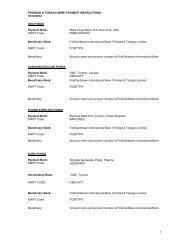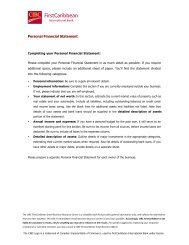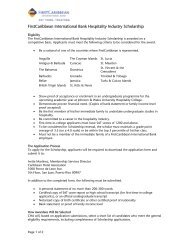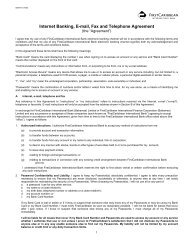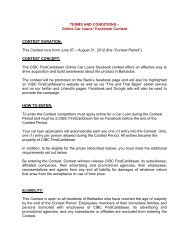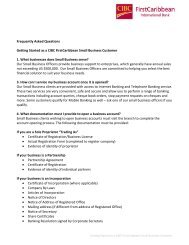(Jamaica) Limited - FirstCaribbean International Bank
(Jamaica) Limited - FirstCaribbean International Bank
(Jamaica) Limited - FirstCaribbean International Bank
You also want an ePaper? Increase the reach of your titles
YUMPU automatically turns print PDFs into web optimized ePapers that Google loves.
notes to the Financial Statements<br />
Year Ended 31 October 2009<br />
(Expressed in <strong>Jamaica</strong>n dollars unless otherwise indicated)<br />
35. Financial Risk Management (Continued)<br />
(e) Market risk<br />
Market risk is the risk that the fair value or future cash flows of financial instruments will fluctuate due to changes<br />
in market variables. Market risk arises from positions in securities and derivatives as well as from the core retail,<br />
wealth and corporate businesses. The key risks to the Group are foreign exchange, interest rate and credit spread.<br />
Management of market risk within the Group is centralized at the Parent which mirrors the way that the hard<br />
currencies are managed by Treasury Sales and Trading and although the local currency exposures are managed in<br />
their respective geographic regions, these exposures are still monitored, measured and controlled centrally from a<br />
market risk perspective.<br />
Policies and Standards:<br />
The Parent Group has a comprehensive policy for market risk management related to its identification and to the<br />
measurement monitoring and control of those risks. This policy is reviewed and approved annually by the Risk and<br />
Conduct Review Committee. The policy includes the annual approval of the Board limits which is used by the Parent<br />
Group to establish explicit risk tolerances expressed in term of the four main risk measures mentioned below. There<br />
is a three tiered approach to limits at the Parent Group. The highest level are those set at the Board level, and the<br />
second level which includes a “haircut” from the Board limits are the Chief Risk Officer limits. The third level of limit is<br />
for the Treasury Sales and Trading Group, which limits traders to specific size of deal, documented through a formal<br />
delegation letter and these are monitored.<br />
Process & Control:<br />
Market risk measures are monitored with differing degrees of frequency dependent upon the relative risk and speed<br />
with which the risk changes. FX positions, Value at risk (VaR) and certain profit & loss measures are all measured daily<br />
whereas others such as stress tests and credit spread sensitivity are performed on either a weekly or monthly basis.<br />
Detailed market risk compliance reports are produced and circulated to senior management on a monthly basis and<br />
a summary version is reported quarterly to the Parent Group Board.<br />
Risk Measurement:<br />
The Group has four main measures of market risk:<br />
• Outright position, used predominantly for FX,<br />
• Sensitivity to a 1 basis point move in a curve, used for both interest rate and credit spread risk,<br />
• Value at Risk (VaR) measures for both interest rate risk and for non pegged currencies<br />
• Stress scenarios based upon a combination of theoretical situations and historical events.<br />
Position:<br />
This risk measurement is used predominantly for the bank’s foreign exchange business. The measure produced and<br />
reported daily focuses upon the outright long or short position in each currency from both a pre-structural and post<br />
structural basis. Any forward contracts or FX swaps are also incorporated.<br />
Sensitivity:<br />
The main two measures utilized by the Group are the DV01 (delta value of a 1 basis point move, also known as the<br />
PV01 or Present value of a 1 basis point move) and the CSDV01 (Credit Spread Delta of a 1 basis point move). The<br />
DV01 measure is calculated for a 1 basis point move down in the yield curve. This generates the effect on earnings<br />
by individual currency of a parallel shift down in the related yield curve. As curves rarely move in a parallel fashion<br />
it is measured across different tenors to ensure that there is not further curve risk of having for example a long<br />
position in the short end of the curve offset by a short position in the longer tenors. This is then utilized within the<br />
scenario analysis. The sensitivities are calculated using two different approaches a pre structural basis that focuses<br />
upon predominantly contractual date positions and also a post structural basis that considers core balances for<br />
non contractual maturities as well as assigning risk to capital and non product general ledger accounts as well as<br />
considering market specific pricing situations that exist in the region. The post structural methodology although<br />
calculated and reported at the Group for a number of years was significantly enhanced during 2009 and has been<br />
used as the input into the stress tests and the VaR models from August 2009.<br />
74



